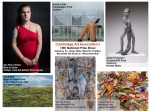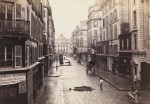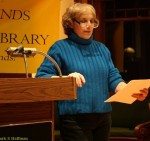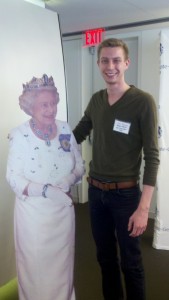Docent/psychoanalyst helps decipher Whitney Biennial 2014 offerings
 The 2014 Whitney Biennial was excoriated as “BS” by the Huffington Post, Even the BBC called the show “confounding and exasperating.” It points out that the the 77th edition of the Whitney Biennial begins with a question, asked at the very start of the text that greets visitors: “What is contemporary art in the United States now?” After seeing the work of 103 artists and groups on display here, a BBC critic suggests, “you might not be any closer to answering that enquiry.”
The 2014 Whitney Biennial was excoriated as “BS” by the Huffington Post, Even the BBC called the show “confounding and exasperating.” It points out that the the 77th edition of the Whitney Biennial begins with a question, asked at the very start of the text that greets visitors: “What is contemporary art in the United States now?” After seeing the work of 103 artists and groups on display here, a BBC critic suggests, “you might not be any closer to answering that enquiry.”
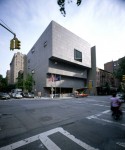 Because I had only a few hours to spare, friends told me not to bother with anything but the exhibits on the fourth floor. But when I arrived at the museum, a tour of the third floor was about to start so I hopped on board. I’m glad I did.
Because I had only a few hours to spare, friends told me not to bother with anything but the exhibits on the fourth floor. But when I arrived at the museum, a tour of the third floor was about to start so I hopped on board. I’m glad I did.
Docent Janice Lieberman explained that the third floor exhibit, curated by Stuart Comer, Chief Curator of Media and Performance Art at the Museum of Modern Art, was meant to show transitions, the blurring of boundaries, changing concepts of internal and external, of gender and sexuality, of political and geographical economy and environment, and the interplay of images and text embodied in art. “What’s an artist, what is art is up for grabs,” she said. “We’re living in a strange time–the disappearing plane off Maylasia, for example, and the shipwreck off Korea.” She pointed out that it’s a time of transition for the Whitney itself, because the current Breuer Building, built in 1966, will close this summer, and the museum will move to a new highrise at the tip of Manhattan,”

Lieberman explained all of the above in the hallway off the elevator of the 3rd floor, where work by Ken Okiishi is displayed on screens resembling large ipods–on which the artist superimposed digital images on old video,then smeared the screen with what looked to me like finger paint. As Okiishi explained to Interview Magazine: “I had already been making straight video works, and then I asked, ‘What if I move even further outside of the screen and work on top of the screen?” According to Lieberman, museum visitors often take photos of this work. thus further blurring boundaries by becoming a part of the work. I dutifully took a photo (top left) but to be honest, was not blown away by these. .  The New England Puritan in me was boggled by photos of Zackary Drucker and Rhys Ernst, a man and a woman who “fell for each other,” as they each switched gender. Disconcerting and meant to be. I could have lived without the photo of their bare behinds, each with a band aid covering the site of a hormone injection.
The New England Puritan in me was boggled by photos of Zackary Drucker and Rhys Ernst, a man and a woman who “fell for each other,” as they each switched gender. Disconcerting and meant to be. I could have lived without the photo of their bare behinds, each with a band aid covering the site of a hormone injection. 
“Meh” to Canopy Canopy Canopy: .com–the work of a collaborative group interested in the history of objects and collections: showing original wooden stand, a reproduction, though others in my tour group were quite impressed by the 3-d printed version o the same.
At one point, when we were standing in front of a workbench amidst sand, tools and other objects, Lieberman said, frankly, “I don’t get this,” I’m not sure if it was she or someone in our group who suggested it was a reference to environmental change. Soon after that, Lieberman warned us that the exhibit gets “stranger and stranger.” 
“The American Dream,” for example, is a collection of paintings by Keith Mayerson, who, Lieberman explained, is a psychoanalyst’s son whose dreams were to show his work in the Whitney–and to come out as gay. As described on the Whitney Website, “The salon-style installation includes images of Annie Oakley, Sitting Bull, Abraham Lincoln, and others, and links these stories to those of the nation and of Mayerson. Paintings of Superman and popular musicians such as Marvin Gaye and the Beatles are juxtaposed with depictions of the artist as a child with his family…and of Mayerson with his husband, Andrew Madrid.” The beautifully composed paintings, with striking brush strokes, hang close together on walls from floor to ceiling. More power to Meyerson and his dream, I say. I also say that it was not MY dream to look up and see a large painting of actor James Dean, in the nude, masturbating.
Less vibrant, less provocative, are hats, placed on the floor as islands on a piece of cloth, meant, to show that New York City is no longer the center of the art world–and that the US is now part of the Pacific Rim. .Another set of three attached hats is used in performance art to show, when worn by three people, what it’s like to try to move anything politically, Lieberman explained.
I found the painting, drawing and tapestry of 89-year-old Lebanese poet Etel Adnan quite inspiring. Adnan, who now lives in California,” makes “accordion-fold books, or leporellos, that meld visual and verbal observation, fusing the artist’s parallel practices in painting and writing as she transcribes poems and records unfolding landscapes and urban spaces,” ![]() .according to the Whitney writeup.
.according to the Whitney writeup. 
Before we entered the last room in the 3rd floor exhibit, Lieberman said that, at first, she’d found its contents shocking. ” I couldn’t believe I’d ever actually show it to people,” filled as it was, with images conveying violence and sex. In fact, she added, the museum considered putting a warning sign in front of the doorway. Norwegian artist Bjarne Melgaard, “goes to the extreme to show the extreme.It’s an example of an artist going to the top to jolt you.” Then, she shrugged. “People love it,” she said. And in we went. The large room was crowded with museum visitors and mannequins standing or sprawled on couches and chairs, amidst mobiles, hanging art, and stuff strewn all over the place–so chaotically that I couldn’t focus. When I heard someone exclaim to a friend, “Look at this,” I did so. She was holding up a pair of stuffed, beachball sized gonads hanging at either end of a long string.
I decided it was time to leave, thanked Lieberman for her frankness and humor, and asked if I could quote her in this piece. “Yes,” she replied. Then she suggested mentioning that, in “real life”, she’s a psychoanalyst –clearly the perfect qualification for guiding people through this show.
Incidentally, I did also visit the fourth floor, curated by Michelle Grabner, an artist and Professor in the Painting and Drawing Department at the School of the Art Institute of Chicago. Grabner’s stated goal was to “develop a curriculum that presents identifiable themes… that are currently established in the textures of contemporary aesthetic, political, and economic realities.” She prioritized “contemporary abstract painting by women; materiality and affect theory; and art as strategy—in other words, conceptual practices oriented toward criticality.”
I found the work she chose more accessible and understandable but far less provocative than the work shown on the third floor. I liked Sheila Hicks “Pillar of Inquiry.” The work of the 80-year-old Nebraska artist melds the weaver’s craft and fine art. 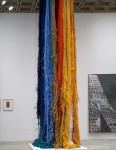 (Photo, left,by Bill Orcut)t. Was also struck by Sterling Ruby’s large, colorful ceramic vessels filled with remnants of earlier works that he had deemed failures or which had accidentally blown up during firing” As explained on the Whitney Website, the finished works contain notions of archaeological excavation, reanimating his own objects exhumed from the past into new, living forms.
(Photo, left,by Bill Orcut)t. Was also struck by Sterling Ruby’s large, colorful ceramic vessels filled with remnants of earlier works that he had deemed failures or which had accidentally blown up during firing” As explained on the Whitney Website, the finished works contain notions of archaeological excavation, reanimating his own objects exhumed from the past into new, living forms. I did wonder if the docent leading the fourth-floor tour I was kidding when she told us Grabner wanted to award “best-in-how” to a “12×12″or so z-shaped- sculpture coated to look like foam rubber– on a pedastal, with a string pulled through it.
I did wonder if the docent leading the fourth-floor tour I was kidding when she told us Grabner wanted to award “best-in-how” to a “12×12″or so z-shaped- sculpture coated to look like foam rubber– on a pedastal, with a string pulled through it.
I was sorry to miss Grabner’s selections of women’s abstract expressionists–and also the second exhibit floor, chosen by Anthony Elms, Associate Curator at the Institute of Contemporary Art, Philadelphia.
Donna De Salvo, Chief Curator and Deputy Director for Programs at the Whitney, noted: “Together, the 103 participants offer one of the broadest and most diverse takes on art in the United States that the Whitney has offered in many years.”
While many critics dumped on the show as a whole, I thought it was fun.
The Biennial runs through May 25, 2014.
–Anita M. Harris
Anita Harris is a writer, photographer and communications consultant based in Cambridge, MA. New Cambridge Observer is a publication of the Harris Communications Group, an award-winning PR and marketing firm in Kendall Square. Cambridge.
